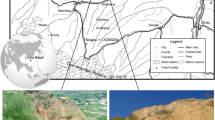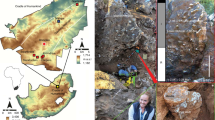Abstract
THE three-toed horse Hipparion was ubiquitous in terrestrial mammalian faunas throughout Holarctica during parts of the Miocene. This report describes Hipparion from the early Barstovian Fleming Formation of the Texas Gulf Coastal Plain. These specimens are assigned to Hipparion because of dental characters such as the diagnostic presence of isolated protocones in the upper molars. This Hipparion is also characterised by a well-developed and anteriorlyrimmed preorbital fossa similar to the condition seen in some Old World forms. Because of this earliest known occurrence, the widely used Hipparion datum concept should be restricted to some palaeogeographically finite area in the Old World.
This is a preview of subscription content, access via your institution
Access options
Subscribe to this journal
Receive 51 print issues and online access
$199.00 per year
only $3.90 per issue
Buy this article
- Purchase on Springer Link
- Instant access to full article PDF
Prices may be subject to local taxes which are calculated during checkout
Similar content being viewed by others
References
Van Couvering, J. A. and Miller, J. A., Nature, 230, 559–563 (1971).
Berggren, W. A. and Van Couvering, J. A., Palaeogeogr., Palaeoclimat., Palaeoecol., 16, 1–216 (1974).
Ameur, R. C., Jaeger, J. J., and Michaux, J., Nature, 261, 38–39 (1976).
Bishop, W. W., and Pickford, M. H. L., Nature, 254, 186–192 (1972).
Hussain, S. T., Verlag Bayer. Akad. Wiss., New Ser., 147, 1–68, (1971).
Hussain, S. T. Nature, 246, 531 (1973).
Simons, E. L., Pilbeam, D. and Boyer, S. J., Nature, 229, 408–409 (1971).
Tedford, R. H., et al., Univ. Calif. Publs Dep. Geol. Sci. Bull. (in the press).
Skinner, M. F., and MacFadden, B. J., J. Paleont. (in the press).
Matthew, W. D., Am. Mus. nat. Hist. Bull., 56, 437–460 (1929).
Stirton, R. A. Univ. Calif. Publs Dep. Geol. Sci. Bull., 25, 165–198 (1940).
Forstén, A. M. Acta zool. fenn., 119, 1–134 (1968).
Teilhard de Chardin, P., and Stirton, R. A., Univ. Calif. Dep. Geol. Sci. Bull., 23, 277–290 (1934).
Colbert, E. H., Am. Mus. nat. Hist. Novit., 797, 1–15 (1935).
Author information
Authors and Affiliations
Rights and permissions
About this article
Cite this article
MACFADDEN, B., SKINNER, M. Earliest known Hipparion from Holarctica. Nature 265, 532–533 (1977). https://doi.org/10.1038/265532a0
Received:
Accepted:
Issue Date:
DOI: https://doi.org/10.1038/265532a0
This article is cited by
-
Supraspecific grouping of Old World hipparions (Mammalia, Equidae)
Paläontologische Zeitschrift (1984)
Comments
By submitting a comment you agree to abide by our Terms and Community Guidelines. If you find something abusive or that does not comply with our terms or guidelines please flag it as inappropriate.



